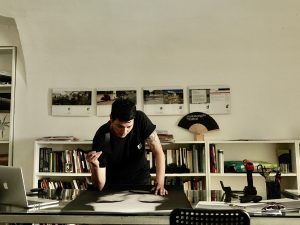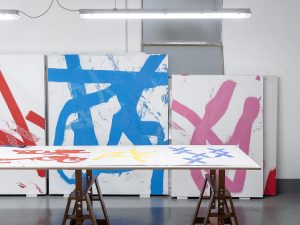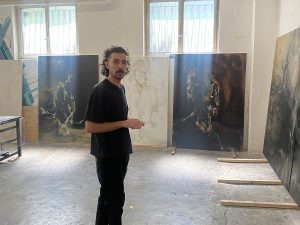«The art critic is an endangered species»[1]
Hal Foster
In recent years, the marginalisation of the role of art criticism has been discussed at length in many different settings, indeed sometimes in heated terms. This is a very real problem, and we may even venture the hypothesis that no one in today’s society can unquestionably claim to do this job full-time, as newspapers and magazines have almost completely stopped calling upon (and adequately paying) people specialised in commenting appropriately on exhibitions and events. So — at least by purely economic parameters — it is difficult to prove that one’s work is primarily that of an art critic. Even one of the profession’s characteristic functions, namely that of interpreting and problematising art, is disappearing: a simple exercise of comparing press releases issued by galleries and museums with published reviews/reports demonstrates a substantial absence of reworking and in-depth analysis in the texts that are offered from one day to the next.
The problem of the disappearance of this role was also posed by Hal Foster in his article ‘Art Agonistes’. Here, he questioned the reasons why the figure of the art critic, so important in the art debate until a few decades earlier, had lost its centrality. His insights lead us to conclude that — even just for the sake of survival — anyone who wants to concern themselves with contemporary art must increasingly gravitate toward the academic sphere. In the Italian case, this implies sticking to the role of art historian. Or — in the case that one has a much broader range of roles available — involvement in a series of art market-related jobs, either directly, working for collectors, galleries, and auction houses, or at least partially indirectly, trying one’s hand at curating but totally giving up on the possibility of practicing any form of criticism. On the other hand, it can hardly be ignored that the apparent ‘poverty’ of today’s criticism is partly the result of a change in our society, primarilyrelated to the speed at which events are consumed and indeed their sheer numbers, which have increased exponentially. In most cases, then, many of the communications propagated on socialmedia channels are influenced by the temperament of those who write (or reply) to the messages without taking the time to observe, re-elaborate or go any deeper. It would thus seem that, to use Hal Foster’s words again, ‘If farce follows tragedy, what follows farce? Along with a modicum of clarity has come a lot of bullshit’.[1]
Perhaps there really was a golden age, a time when art criticism played an unquestionably important role in raising the level of debate and consciousness of artists and audiences. However, I have always been inclined to doubt the existence of such an age, indeed for any kind of phenomenon. I would thus like to try to turn our perspective on its head and start thinking from a seemingly simple question: do we really need art criticism, at least in the terms in which it has been handed down to us historically?
The importance of criticism has grown over time, thanks to art’s historical detachment from its mimetic function. From the point at which artists stopped representing reality by imitating its external forms, criticism’s role of mediation and in-depth exploration, which proceeded via its analysis of literary and philosophical as well as stylistic symbolism, was substantially extended also to the study of the artwork’s psychological or social aspects. This ‘modernist’ phase then underwent subsequent further evolutions, and while artists did not abandon these assumptions altogether, they certainly did head along other paths. The entire history of 20th century art is, in fact, also a history of the exhibitions that developed it and put it on display. In many cases, artists designed their interventions not only in material terms but also in terms of the occupation of space, whether through site-specificinstallations or actual exhibitions. In a certain sense, they put into practice what John Dewey had theorised in Art as Experience,[2] namely the idea that art is a tool for enriching and regenerating our everyday life, and that by virtue of these same characteristics it is also a harbinger of experiential dynamics that interact with the social reality that feeds it. Starting with Schwitters or, if we change perspective, the futurist soirées, passing through various genres of installation and performance, and arriving at the more recent Olafur Eliasson and Damien Hirst, we have witnessed artists’ increasingly evident use of the exhibition/event medium(and the related experiential dynamics to which we alluded). This has altered our way of enjoying art, which, in turn, has been influenced by it.
This change of objectives has, in refocusing attention on the exhibition, made it easier to understand the reasons why (even in the imagination of the youngest) the distant figure of the critic, as observer/commentator, has been replaced by the more active, participating curator’s role. The history of exhibitions also helps us to understand the reasons why this figure now also encompasses strategies and techniques for the realisation of the work that artists have, little by little, introduced into their own repertoires.[3] The ghost of Marcel Duchamp appears before us in all its vividness,[4] as the ‘normal division’ between artist, producer and the curator who selects the works is no longer so clear and defined. This is not only because the ready-madeis the product of a ‘choice’, taking the form of an object not made by the artist, but above all because among his ‘apparently marginal activities’[5] the French artist several times (albeit in different ways) played the role of ‘curator’. Through this role, he deepened his critique of the system of artistic values by attributing increasing importance to the role of the public (also) in the interpretation of the work. The Exposition internationale du surréalisme at the Galerie Beaux-Arts in Paris in 1938, which saw him as ‘générateur-arbitre’,[6] is only the most striking among the possible examples.
If, given the curator’s attention to context, they also become a more ‘coherent’ figure with respect to the object (which has now also become a project, an action, etc.) of their investigation, then likewise art increasingly often takes on a value which stems from its relation to its context. It is worth emphasising that this change does not necessarily imply losing the possibility of approaching reality critically. But it certainly does suggest a gap, a shift that displaces the curator (as opposed to the critic) among the participating observers, with all that follows from this. Such a change of role at least theoretically prompts the curator to move sharply away from their increasingly unconvincing claim to be able to situate themselves outside of things and processes, to abandon that ‘neutral’ gaze that the feminist, anti-colonialist and other experiences have shown is in fact anything but neutral.
On the other hand, it is undeniable that the curator, since the genesis of their role (which we can roughly trace back to the major exhibitions of the late 1960s), has built up an ever-increasing power, which they exercise by including artists in important exhibitions and collections (or else excluding them), or even (and this is sometimes even more fraught with dangers) by imposing a decoding of the individual author or individual work, subservient to the themes proposed in the exhibitions. All too often, the reading of works has been flattened by the collective context and the immersive power of the exhibition, in some cases leading to an erasure of the most unique and subversive elements proposed by individual artists. The shift from critic to curator has not, therefore, solved the problems related to the need to delve into the complexities that are at play; indeed, this is far from the case. Perhaps the desirable attitude, at least on a theoretical level, could be the one invoked by Bruno Latour: ‘The critic is not the one who debunks, but the one who assembles. The critic is not the one who lifts the rugs from under the feet of the naïve believers, but the one who offers the participants arenas in which to gather. The critic is not the one who alternates haphazardly between antifetishism and positivism like the drunk iconoclast drawn by Goya, but the one for whom, if something is constructed, then it means it is fragile and thus in great need of care and caution’[7] .
Despite the appreciable recognition of the need for ‘care and caution’, the overwhelming power of curatorial readings adopted by large museums or biennials continues to stand in contrast to the fragility of possible meanings. This surely makes us regret the disappearance of a criticism that operated outside of the dynamics of exhibitions themselves. However, other elements, coming as the offspring of decolonial thinking and socially engaged art, seem to be emerging from some recent experiments, such as the recent controversial edition of documenta curated by ruangrupa. This latter produced a way of overcoming the traditional confrontation between criticism and curatorship, and offered a horizontal and democratic development of the artistic process, in which the role of the active participant is preferred to both the author-spectator and critic-curator couples. But it is still too early to properly take stock of this further development.[8].
[1] H. Foster, What Comes After Farce?, London-New York,Verso Books, 2020.
[2] J. Dewey, Art as Experience, New York, Capricorn Books, 1934.
[3] B. Groys, Multiple Authorship in The Manifesta Decade, edited by B. Vanderlinden and E. Filipovic, Cambridge (MA), MIT Press, 2005.
[4] In this regard, within a vast literature, I suggest the analyses published in the multiauthor volume: The Dada Seminars, edited by L. Dickerman and M.S. Witkovsky, Washington, National Gallery of Art, 2005. In particular, see the essay by H. Molesworth, entitled ‘Rrose Selavy Goes Shopping’.
[5] E. Filipovic, The Apparently Marginal Activities of Marcel Duchamp, Cambridge (MA), MIT Press, 2016.
[6] This was how the French artist’s work was identified in the exhibition poster.
[7] B. Latour, ‘Why Has Critique Run Out of Steam? From Matters of Fact to Matters of Concern’, Critical Inquiry, II, 2004, p. 246. See also the commentary by Hal Foster, Post-Critical? in Bad New Days: Art, Criticism, Emergency, London-New York, Verso Books, 2015.
[8] On these topics I refer the reader to the texts by: G.H. Kester, The One and the Many. Contemporary Collaborative Art in a Global Context, Durham-London, Duke University Press, 2011 (as well as the texts in the journal Field, which he founded) or that of G. Sholette, The Art of Activism and the Activism of Art, London, Lund Humphries, 2022.





